Palace of Versailles
The Palace of Versailles (/vɛərˈsaɪ, vɜːrˈsaɪ/ vair-SY, vur-SY;[1] French: Château de Versailles [ʃɑto d(ə) vɛʁsɑj] ⓘ) is a former royal residence built by King Louis XIV located in Versailles, about 19 kilometers (12 mi) west of Paris, France. The palace is owned by the French Republic and since 1995 has been managed, under the direction of the French Ministry of Culture, by the Public Establishment of the Palace, Museum and National Estate of Versailles.[2] About 15,000,000 people visit the palace, park, or gardens of Versailles every year, making it one of the most popular tourist attractions in the world.[3]
| Palace of Versailles | |
|---|---|
 | |
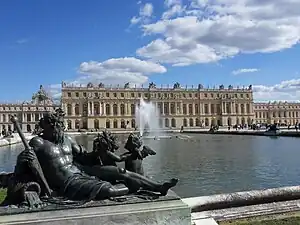 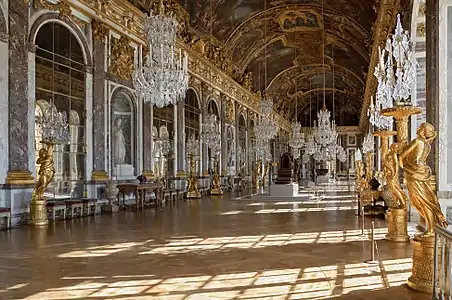 Garden façade and fountains; Hall of Mirrors | |
Interactive fullscreen map | |
| General information | |
| Architectural style | Classicalism and Baroque |
| Location | Versailles, France |
| Coordinates | 48°48′17.3″N 2°7′13.2″E |
| Construction started | 1661 |
| Owner | Government of France |
| Website | |
| en | |
| Official name | Chateau and Park of Versailles |
| Criteria | Cultural: i, ii, vi |
| Reference | 83 |
| Inscription | 1979 (3rd Session) |
| Area | 1,070 ha |
| Buffer zone | 9,467 ha |
Louis XIII built a simple hunting lodge on the site of the Palace of Versailles in 1623. With his death came Louis XIV who expanded the château into the beginnings of a palace that went through several changes and phases from 1661 to 1715. It was a favorite residence for both kings, and in 1682, Louis XIV moved the seat of his court and government to Versailles, making the palace the de facto capital of France. This state of affairs was continued by Kings Louis XV and Louis XVI, who primarily made interior alterations to the palace, but in 1789 the royal family and capital of France returned to Paris. For the rest of the French Revolution, the Palace of Versailles was largely abandoned and emptied of its contents, and the population of the surrounding city plummeted.
Napoleon I, following his coronation, used Versailles as a summer residence from 1810 to 1814, but did not restore it. Following the Bourbon Restoration, when the king was returned to the throne, he resided in Paris and it was not until the 1830s that meaningful repairs were made to the palace. A museum of French history was installed within it, replacing the apartments of the southern wing.
The palace and park were designated a World Heritage Site by UNESCO in 1979 for its importance as the center of power, art, and science in France during the 17th and 18th centuries.[4] The French Ministry of Culture has placed the palace, its gardens, and some of its subsidiary structures on its list of culturally significant monuments.
History
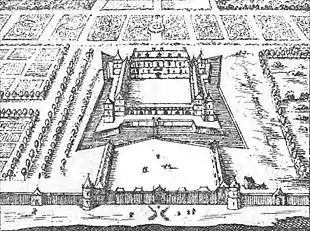
In 1623,[5][6] Louis XIII, King of France, built a hunting lodge on a hill in a favorite hunting ground, 19 kilometers (12 mi) west of Paris,[7] and 16 kilometers (10 mi) from his primary residence, the Château de Saint-Germain-en-Laye.[8] The site, near a village named Versailles,[lower-alpha 1] was a wooded wetland that Louis XIII's court scorned as being generally unworthy of a king;[12] one of his courtiers, François de Bassompierre, wrote that the lodge "would not inspire vanity in even the simplest gentleman".[6][13] From 1631 to 1634, architect Philibert Le Roy replaced the lodge with a château for Louis XIII,[14][15] who forbade his queen, Anne of Austria, from staying there overnight,[16][17] even when an outbreak of smallpox at Saint-Germain-en-Laye in 1641 forced Louis XIII to relocate to Versailles with his three-year-old heir, the future Louis XIV.[16][18]
When Louis XIII died in 1643, Anne became Louis XIV's regent,[19] and Louis XIII's château was abandoned for the next decade. She moved the court back to Paris,[20] where Anne and her chief minister, Cardinal Mazarin, continued Louis XIII's unpopular monetary practices. This led to the Fronde, a series of revolts against royal authority from 1648 to 1653 that masked a struggle between Mazarin and the princes of the blood, Louis XIV's extended family, for influence over him.[21] In the aftermath of the Fronde, Louis XIV became determined to rule alone.[22][23] Following Mazarin's death in 1661,[24] Louis XIV reformed his government to exclude his mother and the princes of the blood,[23] moved the court back to Saint-Germain-en-Laye,[25] and ordered the expansion of his father's château at Versailles into a palace.[16][26]
Louis XIV had hunted at Versailles in the 1650s,[15][18] but did not take any special interest in Versailles until 1661.[27] On 17 August 1661,[28] Louis XIV was a guest at a sumptuous festival hosted by Nicolas Fouquet, the Superintendent of Finances, at his palatial residence, the Château de Vaux-le-Vicomte.[24][29] Louis XIV was impressed by the château and its gardens,[29][30] which were the work of Louis Le Vau, the court architect since 1654, André Le Nôtre, the royal gardener since 1657, and Charles Le Brun,[15] a painter in royal service since 1647.[31] Vaux-le-Vicomte's scale and opulence inspired Louis XIV's aesthetic sense,[6] but also led him to imprison Fouquet that September, as he had also built an island fortress and a private army.[29][32] Louis XIV was also inspired by Vaux-le-Vicomte,[33] and he recruited its authors for his own projects.[34][35] Louis XIV replaced Fouquet with Jean-Baptiste Colbert,[23][30] a protégé of Mazarin and enemy of Fouquet,[36] and charged him with managing the corps of artisans in royal employment.[37][38] Colbert acted as the intermediary between them and Louis XIV,[39] who personally directed and inspected the planning and construction of Versailles.[40][41][42]
Construction

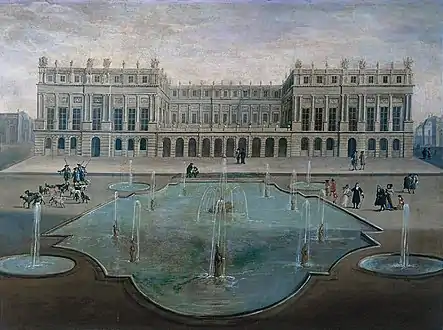
Work at Versailles was at first concentrated on its park and gardens,[43][44] and through the 1660s, Le Vau only added two detached service wings and a forecourt to the château.[45][46] But in 1668–69,[47][48] as a response to the growth of the gardens,[49] and victory over Spain in the War of Devolution,[47][48] Louis XIV decided to turn Versailles into a full-scale royal residence.[45][50] He vacillated between replacing or incorporating his father's château, but settled on the latter by the end of the decade,[47][48][51] and from 1668 to 1671,[52] Louis XIII's château was encased on three sides in a feature dubbed the enveloppe.[48][53] This gave the château a new, Italianate façade overlooking the gardens, but preserved the courtyard façade,[54][55] resulting in a mix of styles and materials that dismayed Louis XIV[55] and that Colbert described as a "patchwork".[56] Attempts to homogenize the two façades failed, and in 1670 Le Vau died,[57] leaving the post of First Architect to the King vacant for the next seven years.[58]
Le Vau was succeeded at Versailles by his assistant, architect François d'Orbay.[59] Work at the palace during the 1670s focused on its interiors, as the palace was then nearing completion,[54][60] though d'Orbay expanded Le Vau's service wings and connected them to the château,[54] and built a pair of pavilions for government employees in the forecourt.[18][61] In 1670, d'Orbay was tasked by Louis XIV with designing a city, also called Versailles,[9] to house and service Louis XIV's growing government and court.[57][62] The granting of land to courtiers for the construction of townhouses that resembled the palace began in 1671.[57][63] The next year, the Franco-Dutch War began and funding for Versailles was cut until 1674,[64] when Louis XIV had work begun on the Ambassadors' Staircase, a grand staircase for the reception of guests, and demolished the last of the village of Versailles.[65]

Following the end of the Franco-Dutch War with French victory in 1678, Louis XIV appointed as First Architect Jules Hardouin-Mansart,[25][66] an experienced architect in Louis XIV's confidence,[67] who would benefit from a restored budget and large workforce of former soldiers.[64][68] Mansart began his tenure with the addition from 1678 to 1681 of the Hall of Mirrors,[69] a renovation of the courtyard façade of Louis XIII's château,[70] and the expansion of d'Orbay's pavilions to create the Ministers' Wings in 1678–79.[71] Adjacent to the palace, Mansart built a pair of stables called the Grande and Petite Écuries from 1679 to 1682[72][73] and the Grand Commun, which housed the palace's servants and general kitchens, from 1682 to 1684.[74] Mansart also added two entirely new wings in Le Vau's Italianate style to house the court,[75] first at the south end of the palace from 1679 to 1681[76] and then at its north end from 1685 to 1689.[18]
War and the resulting diminished funding slowed construction at Versailles for the rest of the 17th century.[64] The Nine Years' War, which began in 1688, stopped work altogether until 1698.[68] Three years later, however, the even more expensive War of the Spanish Succession began and,[77] combined with poor harvests in 1693–94 and 1709–10,[78][79] plunged France into crisis.[79][80] Louis XIV thus slashed funding and canceled some of the work Mansart had planned in the 1680s, such as the remodeling of the courtyard façade in the Italianate style. Louis XIV and Mansart focused on a permanent palace chapel,[64][81] the construction of which lasted from 1699 to 1710.[54][82]
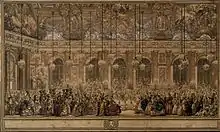
Louis XIV's successors, Louis XV and Louis XVI, largely left Versailles as they inherited it and focused on the palace's interiors. Louis XV's modifications began in the 1730s, with the completion of the Salon d'Hercule, a ballroom in the north wing, and the expansion of the king's private apartment,[83][84] which required the demolition of the Ambassadors' Staircase.[40] In 1748, Louis XV began construction of a palace theater, the Royal Opera of Versailles at the northernmost end of the palace,[85][86] but completion was delayed until 1770;[86][87] construction was interrupted in the 1740s by the War of the Austrian Succession and then again in 1756 with the start of the Seven Years' War.[85][87] These wars emptied the royal treasury and thereafter construction was mostly funded by Madame du Barry, Louis XV's favorite mistress. In 1771, Louis XV had the northern Ministers' Wing rebuilt in Neoclassical style by Ange-Jacques Gabriel, his court architect, as it was in the process of falling down. That work was also stopped by financial constraints, and it remained incomplete when Louis XV died in 1774. In 1784, Louis XVI briefly moved the royal family to the Château de Saint-Cloud ahead of more renovations to the Palace of Versailles, but construction could not begin because of financial difficulty and political crisis.[88] In 1789, the French Revolution swept the royal family and government out of Versailles forever.[54][89]
Role in politics and culture
The Palace of Versailles was key to Louis XIV's politics, as an expression and concentration of French art and culture, and for the centralization of royal power.[90][91] Louis XIV first used Versailles to promote himself with a series of nighttime festivals in its gardens in 1664, 1668, and 1674,[27] the events of which were disseminated throughout Europe by print and engravings.[92][93] As early as 1669,[47] but especially from 1678,[94] Louis XIV sought to make Versailles his seat of government, and he expanded the palace so as to fit the court within it.[95][96][97] The moving of the court to Versailles did not come until 1682,[97] however, and not officially, as opinion on Versailles was mixed among the nobility of France.[13][98]
By 1687, however, it was evident to all that Versailles was the de facto capital of France,[71][99] and Louis XIV succeeded in attracting the nobility to Versailles to pursue prestige and royal patronage within a strict court etiquette,[91][96][100][lower-alpha 2] thus eroding their traditional provincial power bases.[96][97][102] It was at the Palace of Versailles that Louis XIV received the Doge of Genoa, Francesco Maria Imperiale Lercari in 1685,[103] an embassy from the Ayutthaya Kingdom in 1686,[104] and an embassy from Safavid Iran in 1715.[105]
Louis XIV died at Versailles on 1 September 1715 and was succeeded by his five-year-old great-grandson, Louis XV,[78][106] then the duke of Anjou,[107] who was moved to Vincennes and then to Paris by Louis XV's regent, Philippe II, Duke of Orléans.[106] Versailles was neglected until 1722,[18] when Philippe II removed the court to Versailles to escape the unpopularity of his regency,[108][109] and when Louis XV began his majority.[110] The 1722 move, however, broke the cultural power of Versailles,[111] and during the reign of Louis XVI, courtiers spent their leisure in Paris, not Versailles.[18]
.jpg.webp)
During Christmas 1763, Mozart and his family visited Versailles and dined with the kings. The 7-year-old Mozart played several works during his stay and later dedicated his first two harpsichord sonatas, published in 1764 in Paris, to Madame Victoria, daughter of Louis XV.[112]
In 1783, the palace was the site of the signing of the last two of the three treaties of the Peace of Paris (1783), which ended the American Revolutionary War. On September 3, British and American delegates, led by Benjamin Franklin, signed the Treaty of Paris at the Hôtel d'York (now 56 Rue Jacob) in Paris, granting the United States independence. On September 4, Spain and France signed separate treaties with England at the Palace of Versailles, formally ending the war.[113]
The King and Queen learned of the Storming of the Bastille in Paris on 14 July 1789, while they were at the palace, and remained isolated there as the Revolution in Paris spread. The growing anger in Paris led to the Women's March on Versailles on 5 October 1789. A crowd of several thousand men and women, protesting the high price and scarcity of bread, marched from the markets of Paris to Versailles. They took weapons from the city armory, besieged the palace, and compelled the King and royal family and the members of the National Assembly to return with them to Paris the following day.[114]
As soon as the royal family departed, the palace was closed. In 1792, the National Convention, the new revolutionary government, ordered the transfer of all the paintings and sculptures from the palace to the Louvre. In 1793, the Convention declared the abolition of the monarchy and ordered all of the royal property in the palace to be sold at auction. The auction took place between 25 August 1793 and 11 August 1794. The furnishings and art of the palace, including the furniture, mirrors, baths, and kitchen equipment, were sold in seventeen thousand lots. All fleurs-de-lys and royal emblems on the buildings were chambered or chiseled off. The empty buildings were turned into a storehouse for furnishings, art and libraries confiscated from the nobility. The empty grand apartments were opened for tours beginning in 1793, and a small museum of French paintings and art school was opened in some of the empty rooms.[115]
By virtue of an order issued by the Versailles district directorate in August 1794, the Royal Gate was destroyed, the Cour Royale was cleared and the Cour de Marbre lost its precious floor.[116][117]
19th century – history museum and government venue

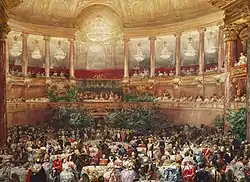
.jpg.webp)
When Napoleon Bonaparte became Emperor of the French in 1804, he considered making Versailles his residence but abandoned the idea because of the cost of the renovation. Prior to his marriage with Marie-Louise in 1810, he had the Grand Trianon restored and refurnished as a springtime residence for himself and his family, in the style of furnishing that it is seen today.[118]
In 1815, with the final downfall of Napoleon, Louis XVIII, the younger brother of Louis XVI, became King, and considered returning the royal residence to Versailles, where he had been born. He ordered the restoration of the royal apartments, but the task and cost was too great. Louis XVIII had the far end of the south wing of the Cour Royale demolished and rebuilt (1814–1824) to match the Gabriel wing of 1780 opposite, which gave greater uniformity of appearance to the front entrance.[119] Neither he nor his successor Charles X lived at Versailles.[118]
The French Revolution of 1830 brought a new monarch, Louis-Philippe to power, and a new ambition for Versailles. He did not reside at Versailles but began the creation of the Museum of the History of France, dedicated to "all the glories of France", which had been used to house some members of the royal family. The museum was begun in 1833 and inaugurated on 30 June 1837. Its most famous room is the Galerie des Batailles (Hall of Battles), which lies on most of the length of the second floor of the south wing.[120] The museum project largely came to a halt when Louis Philippe was overthrown in 1848, though the paintings of French heroes and great battles still remain in the south wing.
Emperor Napoleon III used the palace on occasion as a stage for grand ceremonies. One of the most lavish was the banquet that he hosted for Queen Victoria in the Royal Opera of Versailles on 25 August 1855.[121]
During the Franco-Prussian War of 1870–1871, the palace was occupied by the general staff of the victorious German Army. Parts of the château, including the Gallery of Mirrors, were turned into a military hospital. The creation of the German Empire, combining Prussia and the surrounding German states under William I, was formally proclaimed in the Hall of Mirrors on 18 January 1871. The Germans remained in the palace until the signing of the armistice in March 1871. In that month, the government of the new Third French Republic, which had departed Paris during the War for Tours and then Bordeaux, moved into the palace. The National Assembly held its meetings in the Opera House.[122]
The uprising of the Paris Commune in March 1871, prevented the French government, under Adolphe Thiers, from returning immediately to Paris. The military operation which suppressed the Commune at the end of May was directed from Versailles, and the prisoners of the Commune were marched there and put on trial in military courts. In 1875 a second parliamentary body, the French Senate, was created and held its meetings for the election of a President of the Republic in a new hall created in 1876 in the south wing of the palace. The French Senate continues to meet in the palace on special occasions, such as the amendment of the French Constitution.[123]
20th century
The end of the 19th and the early 20th century saw the beginning of restoration efforts at the palace, first led by Pierre de Nolhac, poet and scholar and the first conservator, who began his work in 1892. The conservation and restoration were interrupted by two world wars but have continued until the present day.[124]
The palace returned to the world stage in June 1919, when, after six months of negotiations, the Treaty of Versailles, formally ending the First World War, was signed in the Hall of Mirrors. Between 1925 and 1928, the American philanthropist and multi-millionaire John D. Rockefeller gave $2,166,000, the equivalent of about thirty million dollars today, to restore and refurbish the palace.[125]
More work took place after World War II, with the restoration of the Royal Opera of Versailles. The theater was reopened in 1957, in the presence of Queen Elizabeth II of the United Kingdom.[126]
In 1978, parts of the palace were heavily damaged in a bombing committed by Breton terrorists.[127]
Starting in the 1950s, when the museum of Versailles was under the directorship of Gérald van der Kemp, the objective was to restore the palace to its state – or as close to it as possible – in 1789 when the royal family left the palace. Among the early projects was the repair of the roof over the Hall of Mirrors; the publicity campaign brought international attention to the plight of post-war Versailles and garnered much foreign money including a grant from the Rockefeller Foundation.
One of the more costly endeavors for the museum and France's Fifth Republic has been to repurchase as much of the original furnishings as possible. Consequently, because furniture with a royal provenance – and especially furniture that was made for Versailles – is a highly sought-after commodity on the international market, the museum has spent considerable funds on retrieving much of the palace's original furnishings.[128]
21st century
In 2003, a new restoration initiative – the "Grand Versailles" project – was started, which began with the replanting of the gardens, which had lost over 10,000 trees during Cyclone Lothar on 26 December 1999. One part of the initiative, the restoration of the Hall of Mirrors, was completed in 2006.[129] Another major project was the further restoration of the backstage areas of the Royal Opera of Versailles in 2007 to 2009.[86]
The Palace of Versailles is currently owned by the French state. Its formal title is the Public Establishment of the Palace, Museum and National Estate of Versailles. Since 1995, it has been run as a Public Establishment, with an independent administration and management supervised by the French Ministry of Culture.[130]
The grounds of the palace will host the equestrian competition during the 2024 Summer Olympics.[131]
Architecture and plan
.jpg.webp)
The Palace of Versailles is a visual history of French architecture from the 1630s to the 1780s. Its earliest portion, the corps de logis, was built for Louis XIII in the style of his reign with brick, marble, and slate,[6] which Le Vau surrounded in the 1660s with Enveloppe, an edifice that was inspired by Renaissance-era Italian villas.[132] When Mansart made further expansions to the palace in the 1680s, he used the Enveloppe as the model for his work.[75] Neoclassical additions were made to the palace with the remodeling of the Ministers' Wings in the 1770s, by Ange-Jacques Gabriel, and after the Bourbon Restoration.[133]
The palace was largely completed by the death of Louis XIV in 1715. The eastern facing palace has a U-shaped layout, with the corps de logis and symmetrical advancing secondary wings terminating with the Dufour Pavilion on the south and the Gabriel Pavilion to the north, creating an expansive cour d'honneur known as the Royal Court (Cour Royale). Flanking the Royal Court are two enormous asymmetrical wings that result in a façade of 402 metres (1,319 ft) in length.[134] Covered by around a million square feet (10 hectares) of roof, the palace has 2,143 windows, 1,252 chimneys, and 67 staircases.[135]
The palace and its grounds have had a great influence on architecture and horticulture from the mid-17th century to the end of the 18th century. Examples of works influenced by Versailles include Christopher Wren's work at Hampton Court Palace, Berlin Palace, the Palace of La Granja, Stockholm Palace,[136] Ludwigsburg Palace, Karlsruhe Palace, Rastatt Palace,[137] Nymphenburg Palace, Schleissheim Palace,[136][138] and Esterházy Palace.[139]
Royal Apartments
.jpg.webp)
The construction in 1668–1671 of Le Vau's enveloppe around the outside of Louis XIII's red brick and white stone château added state apartments for the king and the queen. The addition was known at the time as the château neuf (new château). The grands appartements (Grand Apartments, also referred to as the State Apartments[141]) include the grand appartement du roi and the grand appartement de la reine. They occupied the main or principal floor of the château neuf, with three rooms in each apartment facing the garden to the west and four facing the garden parterres to the north and south, respectively. The private apartments of the king (the appartement du roi and the petit appartement du roi) and those of the queen (the petit appartement de la reine) remained in the château vieux (old château). Le Vau's design for the state apartments closely followed Italian models of the day, including the placement of the apartments on the main floor (the piano nobile, the next floor up from the ground level), a convention the architect borrowed from Italian palace design.[142]
The king's State Apartment consisted of an enfilade of seven rooms, each dedicated to one of the known planets and their associated titular Roman deity. The queen's apartment formed a parallel enfilade with that of the grand appartement du roi. After the addition of the Hall of Mirrors (1678–1684) the king's apartment was reduced to five rooms (until the reign of Louis XV, when two more rooms were added) and the queen's to four.
The queen's apartments served as the residence of three queens of France – Marie-Thérèse d'Autriche, wife of Louis XIV, Marie Leczinska, wife of Louis XV, and Marie-Antoinette, wife of Louis XVI. Additionally, Louis XIV's granddaughter-in-law, Princess Marie-Adélaïde of Savoy, duchesse de Bourgogne, wife of the Petit Dauphin, occupied these rooms from 1697 (the year of her marriage) to her death in 1712.[lower-alpha 3]
Ambassador's Staircase
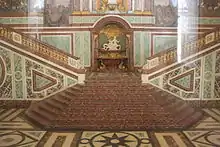
The Ambassadors' Staircase (Escalier des Ambassadeurs) was an imperial staircase built from 1674 to 1680 by d'Orbay. Until Louis XV had it demolished in 1752 to create a courtyard for his private apartments,[143] the staircase was the primary entrance into the Palace of Versailles and the royal apartments especially.[144] It was entered from the courtyard via a vestibule that, cramped and dark, contrasted greatly with the tall, open space of the staircase – famously lit naturally with a skylight – so as to overawe visitors.[145][146]
The staircase and walls of the room that contained it were clad in polychrome marble and gilded bronze,[147] with decor in the Ionic order.[148] Le Brun and painted the walls and ceiling of the room according to a festive theme to celebrate Louis XIV's victory in the Franco-Dutch War.[149] On the wall immediately above the staircase were trompe-l'œil paintings of people from the Four Parts of the World looking into the staircase over a balustrade, a motif repeated on the ceiling fresco.[150][151] There they were joined by allegorical figures for the twelve months of the year and various Classical Greek figures such as the Muses.[152] A marble bust of Louis XIV, sculpted by Jean Warin in 1665–66,[153] was placed in a niche above the first landing of the staircase.[147]
The State Apartments of the King
 Meal at the House of Simon the Pharisee by Veronese in the Salon of Hercules
Meal at the House of Simon the Pharisee by Veronese in the Salon of Hercules.jpg.webp) The Salon of Abundance
The Salon of Abundance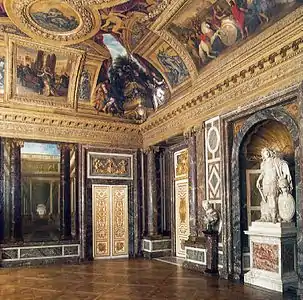 The Salon of Venus
The Salon of Venus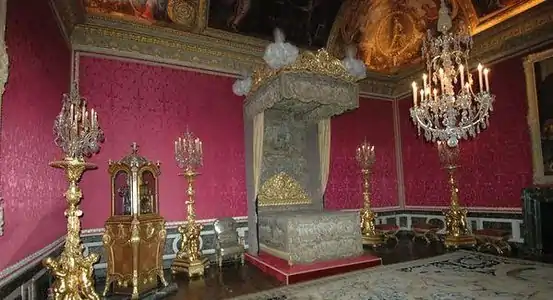 The Salon of Mercury
The Salon of Mercury
The construction of the Hall of Mirrors between 1678 and 1686 coincided with a major alteration to the State Apartments. They were originally intended as his residence, but the King transformed them into galleries for his finest paintings, and venues for his many receptions for courtiers. During the season from All-Saints Day in November until Easter, these were usually held three times a week, from six to ten in the evening, with various entertainments.[154]
The Salon of Hercules
This was originally a chapel. It was rebuilt beginning in 1712 under the supervision of the First Architect of the King, Robert de Cotte, to showcase two paintings by Paolo Veronese, Eleazar and Rebecca and Meal at the House of Simon the Pharisee, which was a gift to Louis XIV from the Republic of Venice in 1664. The painting on the ceiling, The Apotheosis of Hercules, by François Lemoyne, was completed in 1736, and gave the room its name.[154][155]
The Salon of Abundance
The Salon of Abundance was the antechamber to the Cabinet of Curios (now the Games Room), which displayed Louis XIV's collection of precious jewels and rare objects. Some of the objects in the collection are depicted in René-Antoine Houasse's painting Abundance and Liberality (1683), located on the ceiling over the door opposite the windows.
The Salon of Venus
This salon was used for serving light meals during evening receptions. The principal feature in this room is Jean Warin's life-size statue of Louis XIV in the costume of a Roman emperor. On the ceiling in a gilded oval frame is another painting by Houasse, Venus subjugating the Gods and Powers (1672–1681). Trompe-l'œil paintings and sculpture around the ceiling illustrate mythological themes.[156]
The Salon of Mercury
The Salon of Mercury was the original State Bedchamber when Louis XIV officially moved the court and government to the palace in 1682. The bed is a replica of the original commissioned by King Louis-Philippe in the 19th century when he turned the palace into a museum. The ceiling paintings by the Flemish artist Jean Baptiste de Champaigne depict the god Mercury in his chariot, drawn by a rooster, and Alexander the Great and Ptolemy surrounded by scholars and philosophers. The Automaton Clock was made for the King by the royal clockmaker Antoine Morand in 1706. When it chimes the hour, figures of Louis XIV and Fame descend from a cloud.[157]
The Salon of Mars
The Salon of Mars was used by the royal guards until 1782, and was decorated on a military theme with helmets and trophies. It was turned into a concert room between 1684 and 1750, with galleries for musicians on either side. Portraits of Louis XV and his Queen, Marie Leszczinska, by the Flemish artist Carle Van Loo decorate the room today.
The Salon of Apollo
The Salon of Apollo was the royal throne room under Louis XIV, and was the setting for formal audiences. The eight-foot-high silver throne was melted down in 1689 to help pay the costs of an expensive war, and was replaced by a more modest throne of gilded wood. The central painting on the ceiling, by Charles de la Fosse, depicts the Sun Chariot of Apollo, the King's favorite emblem, pulled by four horses and surrounded by the four seasons.
The Salon of Diana
The Salon of Diana was used by Louis XIV as a billiards room, and had galleries from which courtiers could watch him play. The decoration of the walls and ceiling depicts scenes from the life of the goddess Diana. The celebrated bust of Louis XIV by Bernini made during the famous sculptor's visit to France in 1665 is on display here.[158]
Private apartments of the King and Queen
.jpg.webp) The King's bedchamber
The King's bedchamber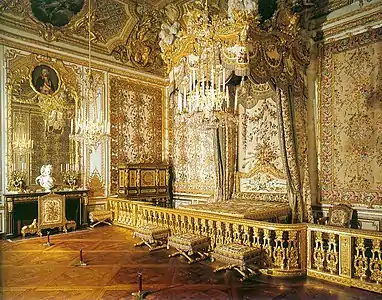 The Queen's bedchamber
The Queen's bedchamber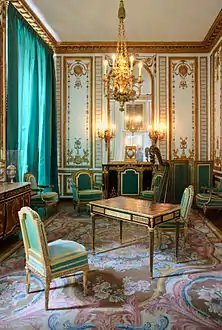 The gilded cabinet of Marie-Antoinette
The gilded cabinet of Marie-Antoinette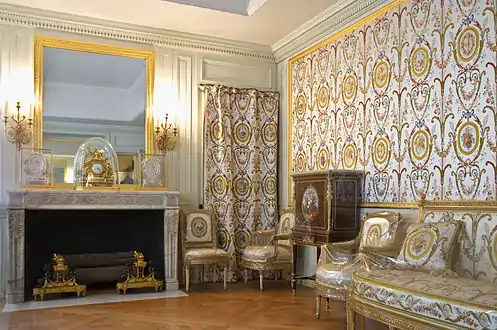 Billiard Room of Marie-Antoinette
Billiard Room of Marie-Antoinette
Private apartments of the King
The apartments of the King were the heart of the château; they were in the same location as the rooms of Louis XIII, the creator of the château, on the first floor (second floor US style). They were set aside for the personal use of Louis XIV in 1683. He and his successors Louis XV and Louis XVI used these rooms for official functions, such as the ceremonial lever ("waking up") and the coucher ("going to bed") of the monarch, which was attended by a crowd of courtiers.
The King's apartment was accessed from the Hall of Mirrors from the Oeil de Boeuf antechamber or from the Guardroom and the Grand Couvert, the ceremonial room where Louis XIV often took his evening meals, seated alone at a table in front of the fireplace. His spoon, fork, and knife were brought to him in a golden box. The courtiers could watch as he dined.[159]
The King's bedchamber had originally been a Drawing Room before Louis XIV transformed it into his own bedroom in 1701. He died there on 1 September 1715. Both Louis XV and Louis XVI continued to use the bedroom for their official awakening and going to bed. On 6 October 1789, from the balcony of this room Louis XVI and Marie-Antoinette, joined by the Marquis de Lafayette, looked down on the hostile crowd in the courtyard, shortly before the King was forced to return to Paris.[159]
The bed of the King is placed beneath a carved relief by Nicolas Coustou entitled France watching over the sleeping King. The decoration includes several paintings set into the paneling, including a self-portrait of Antony van Dyck.[159]
Private apartments of The Queen
The petit appartement de la reine is a suite of rooms that were reserved for the personal use of the queen. Originally arranged for the use of the Marie-Thérèse, consort of Louis XIV, the rooms were later modified for use by Marie Leszczyńska and finally for Marie-Antoinette. The Queen's apartments and the King's Apartments were laid out on the same design, each suite having seven rooms. Both suites had ceilings painted with scenes from mythology; the King's ceilings featured male figures, the Queen's featured females.
Hall of Mirrors

The Hall of Mirrors is a long gallery at the westernmost part of the palace that looks out onto the gardens.[160][161] The hall was built from 1678 to 1681 on the site of a terrace Le Vau built between the king and queen's suites.[69][160] The hall is clad in marble and decorated in a modified version of the Corinthian order, with 578 mirrors facing 17 windows and reflecting the light provided by them. The ceiling fresco, painted by Le Brun over the next four years,[162] embellishes the first 18 years of Louis XIV's reign in 30 scenes,[160] 17 of which are military victories over the Dutch.[163] The fresco depicts Louis XIV himself alongside Classical figures in the scenes celebrating moments in his reign such as the beginning of personal rule in 1661,[164] breaking from earlier frescoes at Versailles that used allegories derived from Classical and mythological scenes.[162][165]
The Salon of War and the Salon of Peace bookend the Hall of Mirrors on its northern and southern ends respectively.[166][167] The Salon of War, constructed and decorated from 1678 to 1686, celebrates French victories in the Franco-Dutch War with marble panels, gilded bronze trophies of arms, and a stucco bas-relief of Louis XIV on horsebask riding over his enemies. The Salon of Peace is decorated in the same fashion but according to its eponymous theme.[160]
Royal Chapel

The Royal Chapel of Versailles is located at the southern end of the north wing.[168] The building stands 40-meter (130 ft) high, and measures 42 meters (138 ft) long and 24 meters (79 ft) wide.[169] The chapel is rectangular with a semicircular apse,[170] combining traditional, Gothic royal French church architecture with the French Baroque style of Versailles.[169][171] The ceiling of the chapel is constituted by an unbroken vault, divided into three frescos by Antoine Coypel, Charles de La Fosse, and Jean Jouvenet.[169] The palette of motifs beneath the frescoes glorify the deeds of Louis IX, and include images of David, Constantine, Charlemagne, and Louis IX, fleur de lis, and Louis XIV's monogram.[172] The organ of the chapel was built by Robert Clicquot and Julien Tribuot in 1709–1710.
Louis XIV commissioned the chapel, its sixth, from Mansart and Le Brun in 1683–84. It was the last building constructed at Versailles during Louis XIV's reign.[54][169][170] Construction was delayed until 1699, however,[54][169] and it was not completed until 1710.[169] The only major modification to the chapel since its completion was the removal of a lantern from its roof in 1765. A full restoration of the chapel began in late 2017 and lasted into early 2021.[173]
Royal Opera
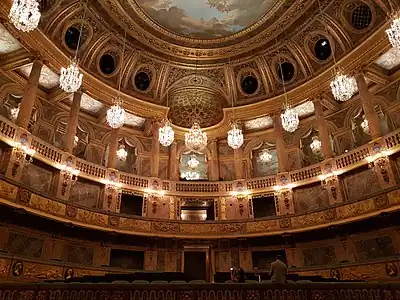 The Opera towards the Royal Box
The Opera towards the Royal Box_-_DSC_0921.jpg.webp) Foyer of the Royal Opera
Foyer of the Royal Opera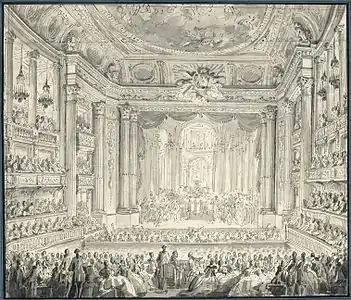 The Royal Opera during the celebration of the marriage of Louis XVI and Marie-Antoinette (1770)
The Royal Opera during the celebration of the marriage of Louis XVI and Marie-Antoinette (1770)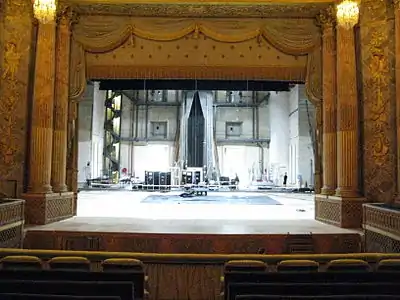 Stage of the Royal Opera
Stage of the Royal Opera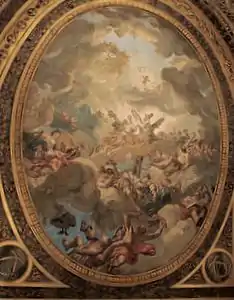 Ceiling of the opera, painted by Louis Jean-Jacques Durameau
Ceiling of the opera, painted by Louis Jean-Jacques Durameau
The Royal Opera of Versailles was originally commissioned by Louis XIV in 1682 and was to be built at the end of the North Wing with a design by Mansart and Vigarani. However, due to the expense of the King's continental wars, the project was put aside. The idea was revived by Louis XV with a new design by Ange-Jacques Gabriel in 1748, but this was also temporarily put aside. The project was revived and rushed ahead for the planned celebration of the marriage of the Dauphin, the future Louis XVI, and Marie-Antoinette. For economy and speed, the new opera was built almost entirely of wood, which also gave it very high quality acoustics. The wood was painted to resemble marble, and the ceiling was decorated with a painting of the Apollo, the god of the arts, preparing crowns for illustrious artists, by Louis Jean-Jacques Durameau. The sculptor Augustin Pajou added statuary and reliefs to complete the decoration. The new Opera was inaugurated on 16 May 1770, as part of the celebration of the royal wedding.[174]
In October 1789, early in the French Revolution, the last banquet for the royal guardsmen was hosted by the King in the opera, before he departed for Paris. Following the Franco-German War in 1871 and then the Paris Commune until 1875, the French National Assembly met in the opera, until the proclamation of the Third French Republic and the return of the government to Paris.[175]
Museum of the History of France
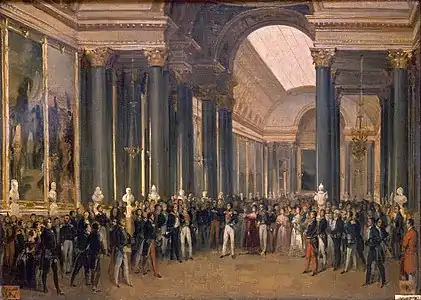 Louis Philippe dedicates the Galerie des Batailles, by François Joseph Heim (1837)
Louis Philippe dedicates the Galerie des Batailles, by François Joseph Heim (1837) The Gallery of Battles in the Museum of the History of France
The Gallery of Battles in the Museum of the History of France The Battle of Taillebourg, by Eugène Delacroix (1837)
The Battle of Taillebourg, by Eugène Delacroix (1837)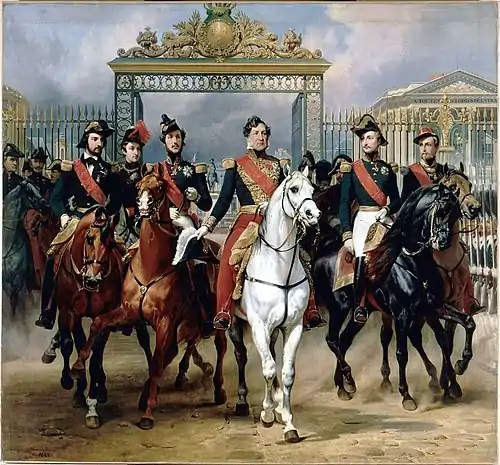 Louis Philippe and his sons pose before the gates of Versailles, by Horace Vernet History Gallery, (1846)
Louis Philippe and his sons pose before the gates of Versailles, by Horace Vernet History Gallery, (1846)
Shortly after becoming King in 1830, Louis Philippe I decided to transform the palace into a museum devoted to "All the Glories of France," with paintings and sculpture depicting famous French victories and heroes. Most of the apartments of the palace were entirely demolished (in the main building, practically all of the apartments were annihilated, with only the apartments of the king and queen remaining almost intact), and turned into a series of several large rooms and galleries: the Coronation Room (whose original volume was left untouched by Louis-Philippe), which displays the celebrated painting of the coronation of Napoleon I by Jacques-Louis David; the Hall of Battles; commemorating French victories with large-scale paintings; and the 1830 room, which celebrated Louis-Philippe's own coming to power in the French Revolution of 1830. Some paintings were brought from the Louvre, including works depicting events in French history by Philippe de Champaigne, Pierre Mignard, Laurent de La Hyre, Charles Le Brun, Adam Frans van der Meulen, Nicolas de Largillière, Hyacinthe Rigaud, Jean-Antoine Houdon, Jean-Marc Nattier, Élisabeth Vigée Le Brun, Hubert Robert, Thomas Lawrence, Jacques-Louis David, and Antoine-Jean Gros. Others were commissioned especially for the museum by prominent artists of the early 19th century, including Eugène Delacroix, who painted Saint Louis at the French victory over the British in the Battle of Taillebourg in 1242. Other painters featured include Horace Vernet and François Gérard. A monumental painting by Vernet features Louis Philippe himself, with his sons, posing in front of the gates of the palace.[176]
The overthrow of Louis Philippe in 1848 put an end to his grand plans for the museum, but the Gallery of Battles is still as it was, and is passed through by many visitors to the royal apartments and grand salons. Another set of rooms on the first floor has been made into galleries on Louis XIV and his court, displaying furniture, paintings, and sculptures. In recent years, eleven rooms on the ground floor between the Chapel and the Opera have been turned into a history of the palace, with audiovisual displays and models.[176]
Estate of Versailles
.jpg.webp)
The estate of Versailles consists of the palace, the subsidiary buildings around it, and its park and gardens. As of June 2021, the estate altogether covers an area of 800 hectares (8.0 km2; 2,000 acres),[177] with the park and gardens laid out to the south, west, and north of the palace.[178] The palace is approached from the east by the Avenue de Paris, measuring 17 miles (27 km) from Paris to a gate between the Grande and Petite Écuries.[179] Beyond these stables is the Place d'Armes,[180][181] where the Avenue de Paris meets the Avenue de Sceaux and Avenue de Saint-Cloud (see map), the three roads that formed the main arteries of the city of Versailles.[46][182] Exactly where the three roads meet is a gate leading into the cour d'honneur,[183] hemmed in by the Ministers' Wings.[180][181] Beyond is the Royal Gate and the main palace,[181] which wraps around the Royal[184] and finally Marble Courts.[185]
The estate was established by Louis XIII as a hunting retreat,[5][186] with a park just to the west of his château.[17] From 1661, Louis XIV expanded the estate until,[187][188] at its greatest extent, the estate was made up by the Grand Parc, a hunting ground of 15,000 hectares (150 km2; 37,000 acres),[186][178] and the gardens, called the Petit Parc,[178] which covered 1,700 hectares (17 km2; 4,200 acres). A 25-mile (40 km) long, 10-foot (3.0 m) high wall with 24 gateways enclosed the estate.[186]
The landscape of the estate had to be created from the bog that surrounded Louis XIII's château using landscape architecture usually employed in fortress building.[189] The approach to the palace and the gardens were carefully laid out via the moving of earth and construction of terraces.[190][191] The water from the marsh was marshalled into a series of lakes and ponds around Versailles,[192] but these reservoirs were not sufficient for the palace, city, or gardens. Great lengths were taken to supply Versailles with water, such as the damming of the river Bièvre to create an inflow in the 1660s, the construction of an enormous pumping station at the river Seine near Marly-le-Roi in 1681, and an attempt to divert water from the river Eure with a canal in the later 1680s.[193][194]
Gardens
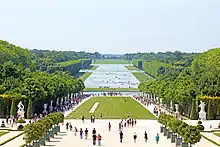
The gardens of Versailles, as they have existed since the reign of Louis XIV, are the work of André Le Nôtre. Le Nôtre's gardens were preceded by a simple garden laid out in the 1630s by landscape architects Jacques Boyceau and Jacques de Nemours,[195] which he rearranged along an east–west axis that,[196] because of Louis XIV's land purchases and the clearing of woodland,[44][189][178] were expanded literally as far as could be seen.[196] The resulting gardens were a collaboration between Le Nôtre, Le Brun, Colbert, and Louis XIV,[191] marked by rigid order, discipline,[44] and open space, with axial paths, flowerbeds, hedges, and ponds and lakes as motifs.[136] They became the epitome of the French formal garden style,[197] and have been very influential and widely imitated or reproduced.[136][178]
Subsidiary structures
The first of the subsidiary structures of the Palace of Versailles was the Versailles Menagerie,[198][199] built by Le Vau between the years 1662 and 1664,[199] at the southern end of the Grand Canal.[198] The apartments, overlooking the pens,[46][200] were renovated by Mansart from 1698 to 1700,[199] but the Menagerie fell into disuse in 1712.[198][lower-alpha 4] After a long period of decay, it was demolished in 1801.[199] The Versailles Orangery, just to the south of the palace,[202] was first built by Le Vau in 1663,[203] originally as part of the general moving of earth to create the Estate.[190] It was also modified by Mansart, who, from 1681 to 1685, totally rebuilt it and doubled its size.[204]
In late 1679,[205] Louis XIV commissioned Mansart to build the Château de Marly,[99] a retreat at the edge of Versailles's estate, about 5 miles (8.0 km) from the palace.[206] The château consisted of a primary residential building and twelve pavilions, in Palladian style[207] placed in two rows on either side of the main building.[208] Construction was completed in 1686,[99][209] when Louis XIV spent his first night there.[205] The château was nationalized and sold in 1799,[208] and subsequently demolished and replaced with industrial buildings. These were themselves demolished in 1805,[210] and then in 1811 the estate was purchased by Napoleon.[208][210] On 1 June 2009, the grounds of the Château de Marly were ceded to the Public Establishment of the Palace, Museum and National Estate of Versailles.[210]
La Lanterne, is a hunting lodge named after the lantern that topped the nearby Menagerie that was built in 1787 by Philippe Louis de Noailles, then the palace governor. It has since 1960 been a state residence.[199]
Petit Trianon
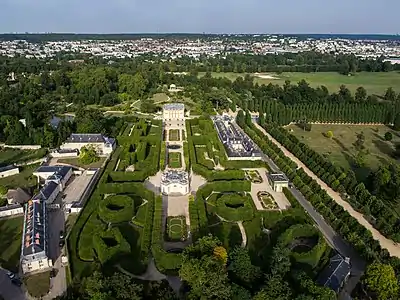 Aerial view of the Petit Trianon and its gardens
Aerial view of the Petit Trianon and its gardens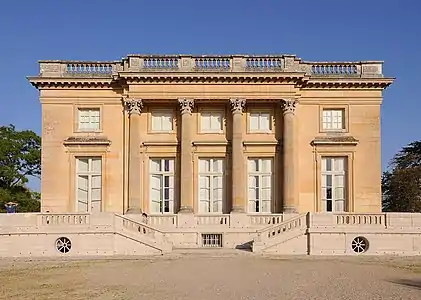 West façade of the Petit Trianon
West façade of the Petit Trianon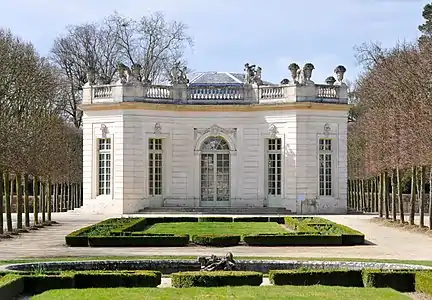 The French Pavilion of the Petit Trianon
The French Pavilion of the Petit Trianon The Belvedere in the park of the Petit Trianon
The Belvedere in the park of the Petit Trianon
The Petit Trianon, whose construction from 1762 to 1768[211] led to the advent of the names "Grand" and "Petit Trianon",[212] was constructed for Louis XV and the Madame du Barry in the Neoclassical style by Gabriel.[213][214] The building has a piano nobile, basement, and attic,[211] with five windows on each floor.[212] On becoming king, Louis XVI gave the Petit Trianon to Marie Antoinette, who remodeled it, relaid its gardens in the then-current English and Oriental styles,[212][215][216] and formed her own court there.[216]
In 1668,[217] Louis XIV purchased and demolished the hamlet of Trianon,[56] near the northern tip of the Grand Canal,[218] and in its place, he commissioned Le Vau to construct a retreat from court,[218][219] remembered as the Porcelain Trianon. Designed and built by Le Vau in 1670,[217][220] it was the first example of Chinoiserie (faux Chinese) architecture in Europe, though it was largely designed in French style.[221][222] The roof was clad not with porcelain but with delftware,[217][218][221] and was thus prone to leaks,[223] so in 1687 Louis XIV ordered it demolished.[217] Nevertheless, the Porcelain Trianon was itself influential and copycats were built across Europe.[218][224]
The Grand Trianon
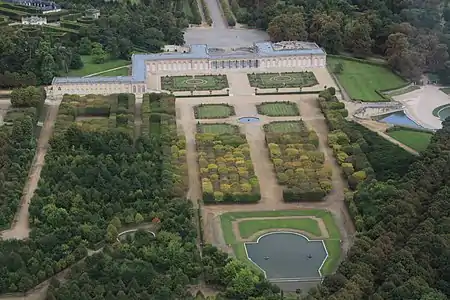 The Grand Trianon with courtyard and gardens. The wing at left is a residence of the President of France.
The Grand Trianon with courtyard and gardens. The wing at left is a residence of the President of France. The Grand Trianon
The Grand Trianon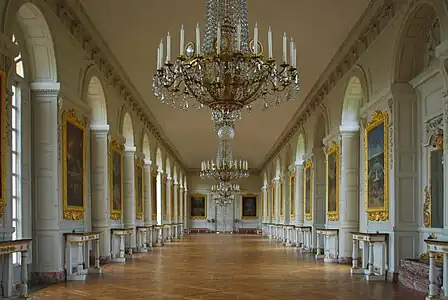 Interior of the Grand Trianon
Interior of the Grand Trianon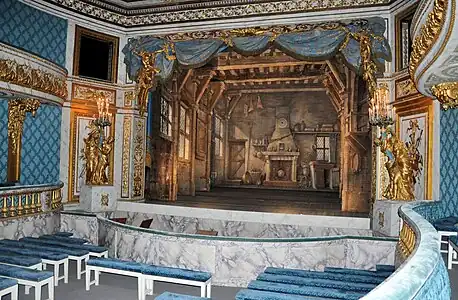 The Queen's Theater
The Queen's Theater
To replace the Porcelain Trianon,[223] Louis XIV tasked Mansart with the construction in 1687 of the Grand Trianon, built from marble in three months.[217] The Grand Trianon has a single story, except for its attached service wing,[225][226] which was modified by Mansart in 1705–06.[227] The east façade has a courtyard while the west faces the gardens of the Grand Trianon, and between them a peristyle.[225][227] The interiors are mostly original,[213] and housed Louis XIV, the Madame de Maintenon, Marie Leszczynska, and Napoleon, who ordered restorations to the building. Under de Gaulle, the north wing of the Grand Trianon became a residence of the President of France.[225]
The Queen's hamlet and Theater

Near the Trianons are the French pavilion, built by Gabriel in 1750 between the two residences, and the Queen's Theater and Queen's Hamlet, built by architect Richard Mique in 1780 and from 1783 to 1785 respectively. These were both built at the behest of Marie Antoinette;[228] the theater, hidden in the gardens, indulged her appreciation of opera and is absolutely original,[213] and the hamlet to extend her gardens with rustic amenities.[228][229][230] The building scheme of the Queen's Hamlet includes a farmhouse (the farm was to produce milk and eggs for the queen), a dairy, a dovecote, a boudoir, a barn that burned down during the French Revolution, a mill and a tower in the form of a lighthouse.
Modern political and ceremonial functions
The palace still serves political functions. Heads of state are regaled in the Hall of Mirrors; the bicameral French Parliament—consisting of the Senate (Sénat) and the National Assembly (Assemblée nationale)—meet in joint session (a congress of the French Parliament) in Versailles[231] to revise or otherwise amend the French Constitution, a tradition that came into effect with the promulgation of the 1875 Constitution.[233] For example, the Parliament met in joint session at Versailles to pass constitutional amendments in June 1999 (for domestic applicability of International Criminal Court decisions and for gender equality in candidate lists), in January 2000 (ratifying the Treaty of Amsterdam), and in March 2003 (specifying the "decentralized organization" of the French Republic).[231]
In 2009, President Nicolas Sarkozy addressed the global financial crisis before a congress in Versailles, the first time that this had been done since 1848, when Charles-Louis Napoleon Bonaparte gave an address before the French Second Republic.[234][235][236] Following the November 2015 Paris attacks, President François Hollande gave a speech before a rare joint session of parliament at the Palace of Versailles.[237] This was the third time since 1848 that a French president addressed a joint session of the French Parliament at Versailles.[238] The president of the National Assembly has an official apartment at the Palace of Versailles.[239]
Gallery
 Panoramic view from the city
Panoramic view from the city Panoramic view from the park
Panoramic view from the park
See also
- Bureau du Roi
- List of Baroque residences
- Paris Peace Conference, 1919
- Style Louis XIV
- Subsidiary structures of the Palace of Versailles
- Tennis Court Oath (French: serment du jeu de paume) in the Saint-Louis district
- Versailles Cathedral
- Potager du roi, Versailles (Kitchen Garden of the King)
Notes
- The name "Versailles", first used in 1038,[9] from the Old French word versail,[10] comes from the Latin word vertere;[11] both mean "ploughed field".[10][11]
- At any given moment during Louis XIV's reign, about 5% of France's nobles were at court in Versailles. Bohanan places the exact number of persons normally present at Versailles as 5,000 nobles and an equal number of commoners,[101] while Blanning gives 1,000 nobles and 4,000 servants.[38]
- Six kings were born in this room: Philip V of Spain, Louis XV, Louis XVI, Louis XVII, Louis XVIII, and Charles X.
- The animals of the Menagerie, abandoned after the Revolution, were moved to Paris and became the foundation of the menagerie of the Jardin des Plantes, the second-oldest public zoo in the world.[201]
Citations
- "Versailles". Dictionary.com. Retrieved 1 July 2021.
- "The Public Establishment". Palace of Versailles. 31 October 2016. Retrieved 20 December 2021.
- "Palace of Versailles (Château de Versailles)". Explore France. Government of France. 18 June 2021.
- "Palace and Park of Versailles". UNESCO World Heritage Centre. United Nations Educational, Scientific, and Cultural Organization. Retrieved 9 October 2021.
- Spaworth 2008, p. 2.
- Ayers 2004, p. 333.
- Spaworth 2008, pp. 1–2.
- Hoog 1996, p. 369.
- City of Versailles: History.
- Jones 2018, p. 12.
- Spaworth 2008, p. 1.
- Jones 2018, p. 15.
- Walton 1986, p. 53.
- Jones 2018, pp. 15–16.
- Berger 1994, p. 53.
- Jones 2018, p. 16.
- Spaworth 2008, p. 3.
- Palace of Versailles: History.
- Bohanan 2001, p. 58.
- Jones 2018, p. 17.
- Bohanan 2001, pp. 58, 60, 66.
- Spaworth 2008, p. 26.
- Bohanan 2001, p. 66.
- Berger 1994, p. 18.
- Jones 2018, p. 25.
- Hoog 1996, pp. 369–70.
- Spaworth 2008, pp. 4–5.
- Bonney 2007, p. 223.
- Blanning 2002, p. 33.
- Jones 2018, p. 19.
- Palace of Versailles: Charles Le Brun.
- Berger 1994, pp. 18–19.
- Walton 1986, p. 41.
- Blanning 2002, p. 40.
- Walton 1986, p. 42.
- Bonney 2007, pp. 208–10.
- Spaworth 2008, p. 5.
- Blanning 2002, p. 36.
- Berger 1994, p. 20.
- Spaworth 2008, p. 9.
- Walton 1986, p. 35.
- Berger 1994, p. 25.
- Walton 1986, pp. 55–63.
- Spaworth 2008, p. 4.
- Ayers 2004, p. 334.
- Berger 1994, p. 54.
- Spaworth 2008, p. 6.
- Walton 1986, p. 67.
- Walton 1986, pp. 62–63, 69.
- Berger 1994, p. 61.
- Berger 1994, pp. 61, 64.
- Ayers 2004, pp. 334–35.
- Berger 1994, p. 64.
- Hoog 1996, p. 370.
- Spaworth 2008, p. 7.
- Jones 2018, p. 24.
- Spaworth 2008, pp. 7–8.
- Berger 1994, p. 22.
- Berger 1985, p. 22.
- Walton 1986, p. 91.
- Jones 2018, p. 22.
- Walton 1986, p. 38.
- Jones 2018, pp. 27–28.
- Walton 1986, pp. 50–51.
- Spaworth 2008, pp. 9, 11.
- Walton 1986, p. 93.
- Berger 1994, pp. 86–87, 113.
- Spaworth 2008, p. 18.
- Berger 1994, p. 115.
- Jones 2018, p. 35.
- Palace of Versailles: Capital.
- Berger 1994, p. 114.
- Palace of Versailles: Royal Stables.
- Palace of Versailles: Grand Commun.
- Spaworth 2008, pp. 10–11.
- Jones 2018, p. 43.
- Walton 1986, p. 51.
- Jones 2018, p. 52.
- Doyle 2001, p. 190.
- Walton 1986, pp. 51–52.
- Spaworth 2008, pp. 17–19.
- Jones 2018, p. 53.
- Jones 2018, p. 59–60, 65.
- Spaworth 2008, pp. 20–21.
- Spaworth 2008, p. 21.
- Palace of Versailles: Royal Opera.
- Jones 2018, p. 61.
- Spaworth 2008, pp. 21–24.
- Spaworth 2008, p. 24.
- Blanning 2002, pp. 33–40.
- Bohanan 2001, pp. 61–64.
- Blanning 2002, p. 49.
- Walton 1986, pp. 57, 59.
- Jones 2018, p. 26.
- Bohanan 2001, p. 62.
- Jones 2018, p. 42.
- Doyle 2001, p. 173.
- Spaworth 2008, p. 14.
- Spaworth 2008, p. 15.
- Blanning 2002, pp. 31–34, 40.
- Bohanan 2001, pp. 62, 64.
- Swann 2001, pp. 143, 145.
- Palace of Versailles: Reception of the Doge of Genoa.
- Palace of Versailles: Reception of the Ambassador of Siam.
- Palace of Versailles: Reception of the Ambassadors of Persia.
- Palace of Versailles: Death of Louis XIV.
- Jones 2018, p. 57.
- Spaworth 2008, p. 20.
- Jones 2018, p. 58.
- Swann 2001, p. 201.
- Doyle 2001, p. 91.
- "Visit from the child Mozart (1763-1764)". The Palace of Versailles. Retrieved 10 July 2023.
- "The Treaty of Paris". www.constitutionfacts.com.
- Lacaille 2012, pp. 16–17.
- Lacaille 2012, p. 18.
- Heitzmann, Annick; Didier, Frédéric (2007). "La Grille et la Cour royales". Versalia. Revue de la Société des Amis de Versailles. 10: 26–43. doi:10.3406/versa.2007.871. Retrieved 7 June 2023.
- Maral, Alexandre (24 October 2018). Octobre 1789: Versailles déserté. Retrieved 7 June 2023.
- Lacaille 2012, p. 19.
- Spaworth 2008, p. 244.
- Hoog 1996, pp. 369–374.
- "Visit of Queen Victoria, 1855". Palace of Versailles. 22 November 2016.
- Lacaille 2012, p. 12.
- Lacaille 2012, p. 20.
- Lacaille 2012, p. 13.
- Iverson, Jeffrey, France Today, 19 July 2014
- "1957 – XXth century – Over the centuries – Versailles 3d". www.versailles3d.com.
- "Versailles Palace Is Damaged By Bomb". The New York Times. 26 June 1978. Retrieved 10 April 2020.
- Kemp 1976, p. 135–137
- Leloup, Michèle (7 September 2006). "Versailles en grande toilette". L'Express (in French). Archived from the original on 15 February 2008. Retrieved 4 January 2021.
- Site of the Public Establishment of the Chateau of Versailles (en.chateauversailles.fr)
- "Château de Versailles". Paris 2024. Retrieved 29 July 2022.
- Berger 1985, pp. 23–25.
- Jones 2018, pp. 61–62, 122.
- "History of Art". Visual Arts Cork. Retrieved 10 August 2016.
- Ayers 2004,also includes 700 rooms. p. 333.
- UNESCO: Palace and Park of Versailles.
- Kaufmann 1995, pp. 320–22.
- Kaufmann 1995, pp. 323–24.
- Kaufmann 1995, p. 338.
- Blondel 1752–1756, vol. 4 (1756), book 7, plate 8; Nolhac 1898, p. 49 (dates Blondel's plan to c. 1742).
- Saule & Meyrer 2000, pp. 18, 22; Michelin Tyre 1989, p. 182.
- Berger 198524–25; Ayers 2004
- Berger 1985, p. 32.
- Yerkes 2015, p. 51.
- Berger 1985, pp. 32–33.
- Yerkes 2015, pp. 67, 69.
- Versailles 3D: 1752.
- Yerkes 2015, p. 72.
- Berger 1985, pp. 32–36.
- Yerkes 2015, pp. 72–73.
- Berger 1985, p. 36.
- Berger 1985, pp. 35–36.
- Berger 1994, p. 7.
- Saule 2013, p. 20.
- Pérouse de Montclos 1991, pp. 262–264.
- Saule 2013, p. 22.
- Saule 2013, p. 25.
- Saule 2013, p. 23.
- Saule 2016, p. 32.
- Palace of Versailles: Hall of Mirrors.
- Berger 1985, p. 51.
- Ayers 2004, p. 337.
- Blanning 2002, p. 38.
- Berger 1985, pp. 53–54.
- Jones 2018, p. 40.
- Spaworth 2008, p. iii.
- Jones 2018, pp. 38–39.
- Ayers 2004, p. 338.
- Palace of Versailles: Royal Chapel.
- Berger 1994, p. 128.
- Berger 1994, pp. 128–35.
- Berger 1994, p. 134.
- Palace of Versailles: Revitalizing the Royal Chapel.
- Saule 2013, p. 60.
- "Palace of Versailles | palace, Versailles, France". Encyclopedia Britannica. Retrieved 28 August 2017.
- Saule 2013, pp. 18–19.
- Palace of Versailles: Estate.
- Walton 1986, p. 29.
- Walton 1986, pp. 13, 15.
- Jones 2018, p. 37.
- Walton 1986, p. 18.
- Spaworth 2008, p. 8.
- Walton 1986, p. 17.
- Jones 2018, p. 38.
- Walton 1986, p. 19.
- Jones 2018, p. 44.
- Hoog 1996, pp. 371–72.
- Jones 2018, pp. 19–20.
- Jones 2018, p. 29.
- Walton 1986, p. 55.
- Palace of Versailles: Gardens.
- Jones 2018, p. 30.
- Spaworth 2008, p. 16–17.
- Jones 2018, p. 30–31.
- Hoog 1996, pp. 369, 371–72.
- Palace of Versailles: André Le Nôtre.
- Jones 2018, p. 46.
- Walton 1986, p. 33.
- Palace of Versailles: Ménagerie.
- Walton 1986, pp. 33, 55.
- Deligeorges, Gady, Labalette, "Le Jardin des Plantes et le Museum National d'Histoire Naturelle" (2004), p. 58
- Palace of Versailles: Orangery.
- Jones 2018, pp. 23–24.
- Berger 1994, p. 107.
- Berger 1994, p. 143.
- Jones 2018, p. 51.
- Berger 1994, pp. 143–44.
- Base Mérimée: Domaine national de Marly.
- Base Mérimée: Château royal de Marly.
- Palace of Versailles: Estate of Marly.
- Hoog 1996, p. 373.
- Palace of Versailles: Petit Trianon.
- Palace of Versailles: Trianon.
- Jones 2018, p. 70.
- Hoog 1996, pp. 373–74.
- Jones 2018, p. 76.
- Hoog 1996, p. 372.
- Berger 1994, p. 68.
- Baghdiantz-MacCabe 2008, p. 214.
- Berger 1994, pp. 26, 68.
- Baghdiantz-MacCabe 2008, p. 215.
- Berger 1994, pp. 68, 118.
- Berger 1994, p. 118.
- Baghdiantz-MacCabe 2008, pp. 216, 219.
- Palace of Versailles: Grand Trianon.
- Berger 1994, pp. 118–19.
- Berger 1994, p. 119.
- Hoog 1996, p. 374.
- Palace of Versailles: Queen's Hamlet.
- Jones 2018, pp. 76–79.
- William Safran, "France" in Politics in Europe (M. Donald Hancock et al., CQ Sage: 5th ed. 2012).
- "Constitution of 1875". Archived from the original on 13 May 2008. Retrieved 2 August 2008.
- Article 9: Le siège du pouvoir exécutif et des deux chambres est à Versailles.[232]
- Associated Press, Breaking tradition, Sarkozy speaks to parliament (22 June 2009).
- Jerry M. Rosenberg, "France" in The Concise Encyclopedia of The Great Recession 2007–2012 (Scarecrow Press: 2012), p. 262.
- Associated Press, The Latest: US Basketball Player James Not Going to France (16 November 2015).
- Associated Press, The Latest: Brother Linked to Paris Attacks in Disbelief (16 November 2015).
- Francois Hollande: 'France is at war', CNN (16 November 2015).
- Georges Bergougnous, Presiding Officers of National Parliamentary Assemblies: A World Comparative Study (Inter-Parliamentary Union: Geneva, 1997), p. 39.
References
- Ayers, Andrew (2004). The Architecture of Paris: An Architectural Guide. Edition Axel Menges. ISBN 9783930698967.
- Baghdiantz-MacCabe, Ina (2008). Orientalism in Early Modern France: Eurasian Trade, Exoticism, and the Ancien Régime. Berg Publishers. ISBN 9781847884633.
- Berger, Robert W. (1985). Versailles: The Château of Louis XIV. Penn State University Press. ISBN 0-271-00412-6.
- Berger, Robert W. (1994). A Royal Passion: Louis XIV as Patron of Architecture. Cambridge University Press. ISBN 0-521-44029-7.
- Blanning, T. C. W. (2002). The Culture of Power and the Power of Culture: Old Regime Europe 1660–1789. Oxford University Press. doi:10.1093/acprof:oso/9780198227458.001.0001. ISBN 978-0-1982-2745-8.
- Blondel, Jacque-François (1752–1756). Architecture françoise, ou Recueil des plans, élévations, coupes et profils des églises, maisons royales, palais, hôtels & édifices les plus considérables de Paris. Vol. 4 vols. Paris: Charles-Antoine Jombert.
- Bluche, François (1986). Louis XIV. Paris: Arthème Fayard.
- Bluche, François (1991). Dictionnaire du Grand Siècle. Paris: Arthème Fayard.
- Bohanan, Donna (2001). Crown and Nobility in Early Modern France. European History in Perspective. Palgrave Macmillan. ISBN 978-0-333-71694-6.
- Bonney, Richard (June 2007). "Vindication of the Fronde? The cost of Louis XIV's Versailles building programme". French History. Oxford University Press. 21 (2): 205–22. doi:10.1093/fh/crm004.
- Constans, Claire (1998). Versailles: Absolutism and Harmony. New York: The Vendome Press. ISBN 9782702811252.
- Dangeau, Philippe de Courcillon, marquis de (1854–1860). Journal. Paris.
{{cite book}}: CS1 maint: location missing publisher (link) CS1 maint: multiple names: authors list (link) - Deligorges, Stephan; Gady, Alexandre; Labalette, Françoise (2004). Le Jardin des plantes et le Muséum national d'histoire naturalle (in French). Éditions du Patrimoine- Centre des Monuments Nationaux. ISBN 978-2-85822-601-6.
- Doyle, William, ed. (2001). Old Regime France. Short Oxford History of France. Oxford University Press. ISBN 0-19-873129-9.
- Swann, Julian. "The State and Political Culture". Old Regime France. pp. 139–68.
- Doyle, William. "Politics: Louis XIV". Old Regime France. pp. 169–94.
- Swann, Julian. "Politics: Louis XV". Old Regime France. pp. 195–222.
- Gady, Alexandre (2010). "Édifices royaux, Versailles: Transformations des logis sur cour". In Gady, Alexandre (ed.). Jules hardouin-Mansart 1646–1708. Paris: Éditions de la Maison des sciences de l'homme. pp. 171–176. ISBN 9782735111879.
- Garrigues, Dominique (2001). Jardins et jardiniers de Versailles au grand siècle. Seyssel: Champ Vallon. ISBN 9782876733374.
- Hoog, Simone (1996). "Versailles". In Turner, Jane (ed.). The Dictionary of Art. Vol. 32. New York: Grove. pp. 369–374. ISBN 9781884446009. Also at Oxford Art Online (subscription required).
- Jones, Colin (2018). Versailles. Basic Books. ISBN 978-1-5416-7338-0.
- Kaufmann, Thomas DaCosta (1995). Court, Cloister, and City: The Art and Culture of Central Europe, 1450–1800. University of Chicago Press. ISBN 978-0-226-42729-4.
- Kemp, Gerard van der (1976). "Remeubler Versailles". Revue du Louvre. 3: 135–137.
- Lacaille, Frédéric (2012). Versailles – 400 ans d'histoire. Paris: Gallimard. ISBN 978-2-07-044430-4.
- La Varende, Jean de (1959). Versailles. Paris: Henri Lefebvre.
- Maral, Alexandre (2010). "Chapelle royale". In Gady, Alexandre (ed.). Jules hardouin-Mansart 1646–1708. Paris: Éditions de la Maison des sciences de l'homme. pp. 215––228. ISBN 9782735111879.
- —— (February 1989). "L'ameublement de la chambre de Louis XIV à Versailles de 1701 à nos jours". Gazette des Beaux-Arts (6th ed.). 113: 79–104.
- Michelin Tyre PLC (1989). Île-de-France: The Region Around Paris. Harrow [England]: Michelin Tyre Public Ltd. Co. ISBN 9782060134116.
- Nolhac, Pierre de (1898). La création de Versailles sous Louis Quinze. Paris: H. Champion.
- Oppermann, Fabien (2004). Images et usages du château de Versailles au XXe siècle (Thesis). École des Chartes.
- Pérouse de Montclos, Jean-Marie (1991). Versailles. Abbeville Press. ISBN 9781558592285.
- Saule, Béatrix; Meyer, Daniel (2000). Versailles Visitor's Guide. Versailles: Éditions Art-Lys. ISBN 9782854951172.
- Spaworth, Anthony (2008). Versailles: A Biography of a Palace. Macmillan Publishers. ISBN 978-0-3123-5785-6.
- Verlet, Pierre (1985). Le château de Versailles. Paris: Librairie Arthème Fayard.
- Walton, Guy (1986). Louis XIV's Versailles. University of Chicago Press. ISBN 978-0-2268-7254-4.
- Wawro, Geoffrey (2003). The Franco-Prussian War: the German conquest of France in 1870–1871. Cambridge University Press.
- Yerkes, Carolyn (Winter 2015). "The Grand Escalier at the Château de Versailles: The Monumental Staircase and its Edges". The Princeton University Library Chronicle. Princeton University Library. 76 (1–2): 51–83. doi:10.25290/prinunivlibrchro.76.1-2.0051. JSTOR 10.25290/prinunivlibrchro.76.1-2.0051.
Web sources
- "Histoire de Versailles" (in French). City of Versailles. Retrieved 16 June 2021.
- "Palace and Park of Versailles". UNESCO. Retrieved 21 June 2021.
French Ministry of Culture
- "Domaine national de Versailles". Base Mérimée (in French). Ministry of Culture. Retrieved 23 June 2021.
- "Domaine national : ancien grand commun (hôpital militaire Dominique Larrey)". Base Mérimée (in French). Ministry of Culture. Retrieved 1 July 2021.
- "Domaine national : Grandes Ecuries". Base Mérimée (in French). Ministry of Culture. Retrieved 1 July 2021.
- "Domaine national : Petites Ecuries". Base Mérimée (in French). Ministry of Culture. Retrieved 1 July 2021.
- "Château royal de Marly". Base Mérimée (in French). Ministry of Culture. Retrieved 26 August 2021.
- "Domaine national de Marly". Base Mérimée (in French). Ministry of Culture. Retrieved 26 August 2021.
- "The History". en.chateauversailles.fr. Public Establishment of the Palace, Museum and National Estate of Versailles. 27 March 2016. Retrieved 1 June 2021.
- "Versailles, "capital" of the kingdom, 1682". en.chateauversailles.fr. Public Establishment of the Palace, Museum and National Estate of Versailles. 22 November 2016. Retrieved 18 June 2021.
- "Reception of the Doge of Genoa, 1685". en.chateauversailles.fr. Public Establishment of the Palace, Museum and National Estate of Versailles. 22 November 2016. Retrieved 23 June 2021.
- "Reception of the Ambassador of Siam, 1686". en.chateauversailles.fr. Public Establishment of the Palace, Museum and National Estate of Versailles. 22 November 2016. Retrieved 23 June 2021.
- "Reception of the Ambassadors of Persia, 1715". en.chateauversailles.fr. Public Establishment of the Palace, Museum and National Estate of Versailles. 22 November 2016. Retrieved 23 June 2021.
- "Death of Louis XIV". en.chateauversailles.fr. Public Establishment of the Palace, Museum and National Estate of Versailles. 23 November 2016. Retrieved 22 June 2021.
- "Louis Le Vau". en.chateauversailles.fr. Public Establishment of the Palace, Museum and National Estate of Versailles. 8 December 2016. Retrieved 16 June 2021.
- "André Le Nôtre". en.chateauversailles.fr. Public Establishment of the Palace, Museum and National Estate of Versailles. 2 November 2016. Retrieved 8 July 2021.
- "Charles Le Brun". en.chateauversailles.fr. Public Establishment of the Palace, Museum and National Estate of Versailles. 2 November 2016. Retrieved 9 July 2021.
- "The Estate". en.chateauversailles.fr. Public Establishment of the Palace, Museum and National Estate of Versailles. 2 September 2016. Retrieved 30 June 2021.
- "The Royal Stables". en.chateauversailles.fr. Public Establishment of the Palace, Museum and National Estate of Versailles. 17 October 2016. Retrieved 17 June 2021.
- "The Park". en.chateauversailles.fr. Public Establishment of the Palace, Museum and National Estate of Versailles. 17 October 2016. Retrieved 29 June 2021.
- "The Estate of Trianon". en.chateauversailles.fr. Public Establishment of the Palace, Museum and National Estate of Versailles. 17 October 2016. Retrieved 7 August 2021.
- "The Grand Trianon". en.chateauversailles.fr. Public Establishment of the Palace, Museum and National Estate of Versailles. 23 November 2016. Retrieved 7 August 2021.
- "The Petit Trianon". en.chateauversailles.fr. Public Establishment of the Palace, Museum and National Estate of Versailles. 23 November 2016. Retrieved 7 August 2021.
- "The Queen's Hamlet". en.chateauversailles.fr. Public Establishment of the Palace, Museum and National Estate of Versailles. 26 April 2018. Retrieved 7 August 2021.
- "The estate of Marly". en.chateauversailles.fr. Public Establishment of the Palace, Museum and National Estate of Versailles. 17 October 2016. Retrieved 26 August 2021.
- "The Gardens". en.chateauversailles.fr. Public Establishment of the Palace, Museum and National Estate of Versailles. 17 October 2016. Retrieved 29 June 2021.
- "The Orangery". en.chateauversailles.fr. Public Establishment of the Palace, Museum and National Estate of Versailles. 8 December 2016. Retrieved 14 August 2021.
- "The Palace". en.chateauversailles.fr. Public Establishment of the Palace, Museum and National Estate of Versailles. 17 October 2016. Retrieved 17 July 2021.
- "The Grand Commun". en.chateauversailles.fr. Public Establishment of the Palace, Museum and National Estate of Versailles. 2 August 2019. Retrieved 18 June 2021.
- "The Royal Chapel". en.chateauversailles.fr. Public Establishment of the Palace, Museum and National Estate of Versailles. 24 October 2018. Retrieved 5 September 2021.
- "The Royal Opera". en.chateauversailles.fr. Public Establishment of the Palace, Museum and National Estate of Versailles. 27 March 2016. Retrieved 25 June 2021.
- "The Hall of Mirrors". en.chateauversailles.fr. Public Establishment of the Palace, Museum and National Estate of Versailles. 27 March 2016. Retrieved 17 July 2021.
- "Revitalising the Royal Palace". en.chateauversailles.fr. Public Establishment of the Palace, Museum and National Estate of Versailles. 24 October 2018. Retrieved 5 September 2021.
- Saule, Béatrix. "Ménagerie". sculpturesversailles.fr (in French). Public Establishment of the Palace, Museum and National Estate of Versailles. Retrieved 16 August 2021.
- "1752: La destruction de l'escalier des Ambassadeurs". Versailles 3D (in French). Public Establishment of the Palace, Museum and National Estate of Versailles. Retrieved 19 November 2021.
Further reading
- Mansel, Philip. King of the World: The Life of Louis XIV (2020) chapters 8, 13.
.png.webp)

.jpg.webp)
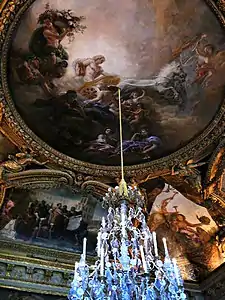
_00.jpg.webp)
.jpg.webp)



